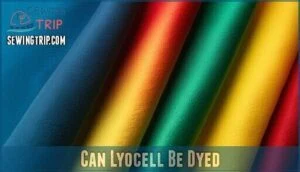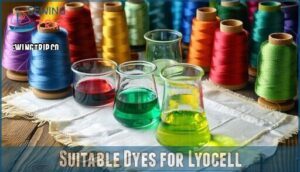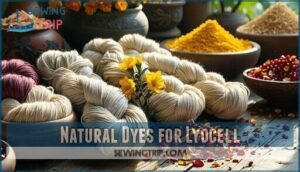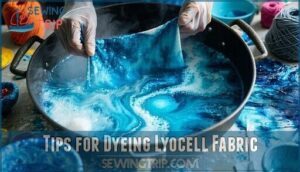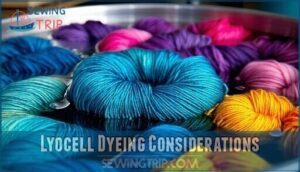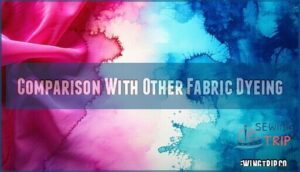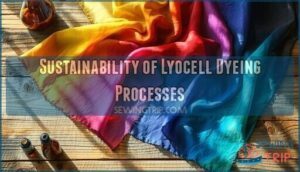This site is supported by our readers. We may earn a commission, at no cost to you, if you purchase through links.
 Yes, you can dye lyocell, and it’s surprisingly simple! This eco-friendly fabric takes dye beautifully due to its smooth, absorbent fibers, giving you vibrant, even colors.
Yes, you can dye lyocell, and it’s surprisingly simple! This eco-friendly fabric takes dye beautifully due to its smooth, absorbent fibers, giving you vibrant, even colors.
Use fiber-reactive dyes for the best results, especially if you want long-lasting shades. Natural dyes work too, though they may offer softer, earthy tones.
Always wash the fabric first to remove any finishes that might block the dye. Whether you’re using a bucket, a washing machine, or hand-painting, the process is flexible and fun.
Just watch out for shrinkage—lyocell can be finicky with heat. Want professional-quality results? The secret’s all in the prep!
Table Of Contents
Key Takeaways
- You can easily dye lyocell using fiber-reactive or natural dyes for vibrant, long-lasting results.
- Always wash the fabric beforehand to remove finishes that might block dye absorption.
- Handle lyocell carefully during dyeing to prevent shrinkage and maintain its smooth texture.
- Use low heat and gentle drying methods to protect the fabric’s shape and color.
Lyocell Fabric Overview
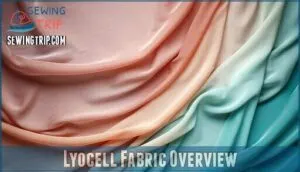
Lyocell is a versatile fabric made from wood pulp, using an eco-friendly process that recycles nearly all solvents.
Known for its strength, softness, and absorbency, it’s a great choice for clothing and home textiles.
Lyocell Production Process
Lyocell is crafted from wood pulp, processed with the NMMO solvent.
This eco-friendly method spins cellulose into resilient fibers. The fibrillation process, where fibers split into microfibrils, enhances texture and performance.
Key features of lyocell production include:
- Fiber formation that’s eco-conscious
- Crystal structure ensuring strength
- Minimal waste from production
- Support for sustainable dyeing techniques
It’s a true breakthrough for cellulosic fibers.
Environmental Impact of Lyocell
Producing lyocell is impressively ecofriendly. It uses NMMO recycling to cut waste, requires less water, and reduces pesticides compared to traditional fibers.
This biodegradable fabric supports sustainable production while offering durability. If you’re passionate about sustainable fabric dyeing, lyocell stands out as an environmentally wise choice.
It pairs beautifully with ecofriendly fabric dye for guilt-free fashion.
Lyocell Fiber Properties
Strong and smooth, lyocell stands out for its fiber tenacity, absorbing moisture better than most cellulose fibers.
Its crystalline structure boosts durability, while fibrillation tendency creates a soft, unique texture.
Thanks to its environmental friendliness, it’s a favorite for sustainability fans.
Wondering, “Can lyocell be dyed?” Absolutely, its fiber properties make dyeing lyocell versatile and effective for vibrant, lasting results.
Can Lyocell Be Dyed
Wondering if lyocell can be dyed? Absolutely! This versatile fabric absorbs dyes well, offering vibrant and uniform colors when done right.
Its cellulose structure makes it compatible with a variety of dye types, though careful handling is key to prevent fiber degradation.
Here’s what you need to know:
- Dye Selection: Choose reactive dyes or natural options for the best results.
- Dye Uptake: Lyocell fabric holds color beautifully but benefits from controlled conditions to guarantee color uniformity.
- Dyeing Challenges: Over-wetting or harsh treatments can weaken the fibers, so follow instructions closely.
People love lyocell for its eco-friendliness and smooth finish, and dyeing it just adds versatility.
For vibrant, long-lasting results, consider acid dyes usage. With some patience and the right materials, your projects will shine!
Dyeing Lyocell Fabric
Yes, you can dye lyocell, and it’s both flexible and rewarding to work with.
Using the right dyes and techniques guarantees vibrant, long-lasting colors while maintaining the fabric’s smooth texture.
Suitable Dyes for Lyocell
If you’re thinking about dyeing lyocell, choosing the right dye matters.
Reactive Dyes, Acid Dyes, Direct Dyes, and Disperse Dyes all work well for lyocell fabric.
They bond effectively, offer vibrant shades, and maintain durability.
For simpler projects, consider tie-dyeing techniques for unique patterns.
Here’s a quick comparison:
| Dye Type | Features | Usage Temp. | Fixatives Needed | Best For |
|---|---|---|---|---|
| Reactive Dyes | Vibrant, durable | Medium | Yes | Cellulose fibers |
| Acid Dyes | Rich colors | High | Yes | Animal fiber blends |
| Direct Dyes | Easy to apply | High | Sometimes | Simple applications |
| Disperse Dyes | Consistent results | Moderate | Yes | Synthetic fiber content |
| Fiber Reactive | Bond durability | Medium-High | Yes | Eco-friendly options |
This comparison highlights the importance of selecting the best dye for your specific needs, considering factors such as usage temperature and fixatives needed, to achieve the desired results with lyocell fabric and ensure bond durability.
Dyeing Techniques for Lyocell
When dyeing lyocell, knowing the right techniques makes all the difference.
The dyeing process works best with these methods:
- Exhaust dyeing: Use reactive dyes at moderate temperatures.
- High-temperature dyeing: Ideal for even color absorption.
- Ultrasonic dyeing: Enhances precision.
- Causticization: Preps fibers for reactive dyes.
- Acid padding: Applies dyes directly for bold shades.
Consider exploring options for Lyocell reactive dyes for superior results.
Focus on fabric care for color fastness!
Natural Dyes for Lyocell
Natural dyes like pomegranate peel, marigold flowers, and gardenia work wonderfully for dyeing lyocell.
These plant-based dyes, paired with dyeing mordants like ferrous sulfate, boost color fastness and environmental benefits.
Applying these dyes is simple and eco-friendly, perfect for dyeing natural fibers at home.
You can find various lyocell products designed for natural dyeing.
Experimenting with natural options lets you explore vibrant hues while supporting sustainable dyeing methods.
Tips for Dyeing Lyocell Fabric
Mastering how to dye lyocell fabric requires a few key tricks:
- Pre-Treatment Options: Wash thoroughly to remove residues.
- Dye Bath Temperature: Keep it between 40-60°C for even color absorption.
- Dyeing Time Impact: Longer dyeing enhances richness but watch for over-saturation.
- Post-Dyeing Care: Rinse with cool water, then air dry to protect your masterpiece. Some find success with specific dyeing products.
Lyocell Dyeing Considerations
When dyeing lyocell, you’ll want to account for factors like color fastness, durability, and fabric care to guarantee the best results.
Understanding how lyocell behaves with shrinkage or blends can help you avoid common challenges and achieve vibrant, long-lasting colors.
Color Fastness and Durability
When dyeing lyocell, focus on color fastness and durability.
Make certain the dye has excellent light fastness, wash resistance, and rub fastness to prevent color fading or transfer.
Without proper care, dye bleeding can occur, lowering color retention.
Testing lyocell fabric dye with small swatches helps gauge dye fastness and wash fastness.
Quality dyes minimize fading, offering vibrant, long-lasting results.
Certain fabrics, like polyester, are known for their inherent bleach resistance, which contributes to their durability and wash resistance.
Shrinkage and Fabric Care
Fabric dyeing tips for lyocell start with controlling pre-dyeing shrinkage.
Keep an eye on the dyeing temperature—too high, and your Tencel fabric may stretch or distort.
After dyeing, focus on proper post-dyeing care to minimize color bleeding.
Use gentle drying methods, like air-drying or low-heat cycles, to protect the fabric’s shape and guarantee it looks great longer.
Blending Lyocell With Other Fibers
Blending lyocell with other fibers, like cotton or silk, creates unique fabric properties like enhanced softness and strength.
These blended fabrics require careful dyeing to balance dye uptake and texture variation.
Since lyocell is a cellulosic fiber, it works well with reactive and natural dyes.
Achieving consistent colors in blend dyeing demands understanding how each fiber combination reacts during the process.
Specialized Dyeing for Lyocell Blends
Dyeing lyocell blends like union fabrics involves customized methods, including fiber reactive dye and cross-dyeing techniques.
For synthetic blends, Rit is the best dye for lyocell, offering smooth results. Resin finishing enhances color fastness and durability.
While dyeing Tencel fabric at home, handle fibers gently to prevent damage. Specialized dyes guarantee vibrant hues and maintain the blend’s integrity, using techniques like cross-dyeing.
Lyocell Dyeing Results
You can achieve vibrant, long-lasting colors on lyocell with the right techniques and dyes.
The results depend on precise dye selection and process control, ensuring both color quality and fabric durability.
Achieving Desired Colors and Shades
Nailing the right shades on lyocell takes finesse. Pay attention to dye concentration, dyeing time, and temperature control for even color matching.
For lyocell color change or tencel fabric dye success:
- Use reactive dyes for depth and vibrancy.
- Maintain steady dyeing temperatures (40-60°C).
- Monitor the dyeing process to balance shade depth.
Adjust as needed for your perfect result!
Enhancing Fabric Properties With Dyeing
By tweaking the dyeing process for lyocell, you can greatly improve fabric properties.
Dyeing cellulose fibers enhances durability and performance, adding a smoother handle, vibrant luster, and appealing texture modifications.
Lyocell’s fabric dyeability allows for versatile customization, boosting both function and style, while its natural softness and eco-friendly benefits are maintained, resulting in long-lasting results.
Comparison With Other Fabric Dyeing
Lyocell stands out with its smooth, vibrant dye uptake compared to cotton dyeing or even polyester dyeing.
It’s less complex than wool dyeing, requiring no special acidic conditions.
Here’s why:
- Lyocell absorbs reactive dyes faster than many cellulose fibers like modal or tencel.
- It simplifies blend dyeing, pairing well with nylon.
- Its silky finish beats traditional cotton’s texture effortlessly.
To maintain the fabric’s quality, consider gentler stain removal instead of harsh chemicals.
Sustainability of Lyocell Dyeing Processes
Sustainable fabric dyeing with lyocell stands out for eco-friendly dyes, water conservation, and energy reduction.
Using low-impact dyes and chemical alternatives, you minimize waste and protect the environment.
Techniques like enzymatic treatments reduce water use during processes like bleaching.
These steps make dyeing lyocell a smart choice for lowering environmental impact while maintaining vibrant, durable colors.
Frequently Asked Questions (FAQs)
What kind of dye to use on Lyocell?
Use reactive dyes like Dypro Multi-Purpose or Jacquard iDye Natural for vibrant, long-lasting results on lyocell.
They bind well to cellulose fibers.
Just follow instructions carefully—add salt or soda for the best color payoff.
What type of fabric cannot be dyed?
Even the best materials have their limits—polypropylene, imitation leather, and polyurethane-coated fibers can’t absorb traditional dyes.
For these, surface painting with acrylic varnishes or sprays works best, keeping things vibrant without soaking colors in, which is a method that utilizes acrylic varnishes.
Can you dye tencel with Rit dye?
Yes, you can dye Tencel with Rit All-Purpose Dye, but it works best with colors on lighter fabrics.
For brighter or deeper shades, try Rit DyeMore, specially made for synthetic fibers like Tencel.
Can you put 100% Lyocell in the dryer?
Throwing lyocell in the dryer can feel like rolling the dice.
It’s safer to air-dry, as heat might cause shrinkage or damage its silky fibers.
If necessary, use low heat and monitor closely.
What are the best dyes to use for dyeing lyocell?
The best dyes for lyocell are reactive dyes like Jacquard Procion MX or acid dyes for blends with silk.
For polyester blends, use Jacquard iDye Poly.
These dyes guarantee vibrant, long-lasting results with proper care.
Is it possible to bleach lyocell fabric?
Bleaching lyocell is like giving it a fresh start—it’s doable, but be cautious.
Use oxygen-based bleach (not chlorine) to avoid weakening fibers.
Always follow care labels and test a hidden area first.
Are there any special washing instructions for lyocell fabric?
Wash lyocell in cold water on a gentle cycle, using mild detergent.
Avoid bleach, fabric softeners, or high heat.
Air-dry if possible, and iron on a low setting to prevent damage.
How should lyocell fabric be stored?
Think of lyocell as a plant that thrives in balance—store it in a cool, dry place, away from sunlight.
Use breathable bags for ventilation and avoid plastic to prevent moisture buildup or yellowing.
Are there any special considerations when sewing with lyocell fabric?
When sewing lyocell, use sharp needles to avoid snagging the delicate fibers.
Pre-wash the fabric to prevent shrinkage, and handle gently since it frays easily.
Press seams lightly with medium heat to maintain its structure.
How does humidity affect dyed lyocell fabrics?
Humidity can reduce the vibrancy of dyed lyocell by causing uneven moisture absorption, which affects color consistency.
It’s like painting on a damp canvas—colors might bleed or fade faster, so store and handle carefully.
Conclusion
Think of lyocell as a blank canvas ready for vibrant transformation.
Yes, you can dye lyocell, and its absorbent fibers make the process straightforward and rewarding.
Use fiber-reactive dyes for rich, long-lasting colors or natural dyes for earthy tones.
Always prepare the fabric by washing it first, and handle it carefully to avoid shrinkage.
Experiment with techniques to achieve unique results, and with a bit of effort and care, dyeing lyocell can elevate your projects beautifully and sustainably.

